After I was relocated to Sepoy Lines last April for my work project, Chinatown became one of my many lunchtime playgrounds. There were times I walked to Yan Kit Road, to try out the food centre and coffee shops at Tanjong Pagar Plaza. It was an never-ending discovery, as I would try out a new eating place each day, never to repeat the same shop later. In this latest adventure, I found out at last where the nasi biryani stall from Tanjong Pagar Railway Station relocated after June 2011. However food is not my topic today.
Beside Ali Machia Biryani Dam and other good food, Tanjong Pagar Plaza (Blk 1 to 5) has another "best-kept secret". Hidden from Tanjong Pagar Road by the plaza and tucked between the plaza and Yan Kit Road is Singapore's oldest surviving public pool, which closed in 2001. Note it is oldest surviving, not oldest; that honour goes to the public pool at Mount Emily which closed in 1981 due to under-utilisation. Do be aware of false leads when you do research; the SSC sports museum lists Jan 1931 as the date of Yan Kit Swimming Complex's opening. This is most untrue and they probably mixed up with the pool at Mount Emily which was opened in that month and year.
Barbed wires protect the compound against potential trespassers from the rooftop carpark. This deterrence was not very successful, judging from the number of Yan Kit exploration photos online taken inside the compound. Diving platform and entrance building in the background.
After a long absence I was back at Yan Kit for my lunchtime adventure. I was not surprised to see the place boarded up; it was in December last year that the papers reported on its demolition and the news impelled me on one last visit. Regrettably I did not take photos before the excavators moved in, not aware the disused swimming complex before me was living on borrowed time. It was a sorry sight that day; the soil had eaten up everything except the deepest part of the main pool, and only the entrance building was left standing. The whole place is now a construction site. With the demolition of Yan Kit, our three earliest public pools are history (the other two being Mount Emily and River Valley). Farrer Park, under private management, should be the oldest operational pool today. Make a guess - where is the oldest pool under SSC today?
An empty trough with the diving platform and building that would soon disappear and become history.
As one witnesses history being made in the demolition of Yan Kit Pool, one often wonders how the pool has made history and its legacy today.
Early photo of Yan Kit Pool showing, in increasing distance from the camera, the shallow pool, the practice pool and the main pool (source: NHB). See this modern-day photo for comparison. The buildings on the right were demolished for the construction of Tanjong Pagar Plaza. The only surviving heritage in the photo is the row of three-storey shophouses on the left.
Yan Kit can be considered the prototype of our public pools. The pool design deviated from Mount Emily constructed 2 decades before - instead of one large pool it has three separate pools: a main pool, a practice pool and a shallow pool. This basic concept has not changed, only the terminology by SSC. Bedok Swimming Complex where I grew up learning to swim has a competition pool (main pool), a teaching pool (practice pool) and a wading pool (shallow pool). There is also a learner pool not present in smaller swimming complexes; that would be the deep end of the shallow pool at Yan Kit. By the way, Queenstown has the only diving pool under SSC stable at 4.5m and guess what, Yan Kit have had a diving end at the main pool 60 years ago!
An excavator digging away at what was once the practice pool and shallow pool.
An intriguing case, an unfortunate accident took place at the pool less than a week after it commenced operation in 1952. 18-year-old Ponnusamy was found drowned at the bottom of the main pool, 12 hours after he was reported missing. The Coroner returned a verdict of misadventure. I do not know how a corpse can stay in the pool - without being noticed by swimmers and lifeguards - and also like a rock at the bottom. I thought all dead bodies float? With regards to my second query, this website explains why drowned bodies do not float up immediately.
I am not sure if diving was in the Olympics by the 1950s but Yan Kit had its fair share of diving wannabes who were not the most cautious of people. The diving board was often the accident spot. The Straits Times of 21 May 1956 read "Diver Lands Himself in Hospital":
Wong Chok Keng, 20, did a double-somersault from a 20ft. high diving board at Singapore's Yan Kit swimming pool yesterday - and landed in hospital with neck injuries. Swimmers gasped in horror as they saw Wong slip and crash on to a lower board before hitting the water.
As part of my second shot training, I like to compare old and recent photos taken from similar angle of the same spot. Examine an early photo of Yan Kit and notice floodlights are missing in the photo. There is much to learn from this omission. Night swimming we take for granted today was introduced at Yan Kit in 1954, two years after its opening. Thanks to the floodlights, it became possible to swim at night and opening hours was extended from 6.30pm to 9.30pm everyday. The success of this floodlight experiment paved the way for Mount Emily to be floodlit.
Old photo of Yan Kit Pool (source: NHB). Compare with this recent lomography photo (almost a second shot!) taken by some adventurous folks who sneaked inside. Other than missing diving boards and dry trough, the Pool remained practically unchanged after half a century. Amazing!
One intriguing practice at Yan Kit was the single and mixed bathing sessions enforced in the 1950s. Single sessions were reserved for either gender and mixed sessions for both genders. Therefore while there were changing rooms for men and women, only half the dressing rooms were used during single sessions. I understand this was done to protect the girls' modesty so shy girls could swim in peace, but I thought the idea is a bit silly considering this is an open air pool and everyone is exposed from Yan Kit Road on top. There was even suggestion to restrict men to single session unless they were accompanied by women during mixed sessions. How did management enforce the rule I am not sure; they chased out all the males just before the female session? I also do not know when this archaic practice became extinct.
Back to the modern day. My visit to Yan Kit Pool at the closing chapter of its history also had me stumbling on something unrelated ... but still significant enough to blog about it. A banner greets the public at the carpark beside the flight of stairs to the swimming complex and on it, a festive greeting by the Tanjong Pagar - Tiong Bahru constituency to all residents. I was a little surprised by the only member of parliament in the banner who also happens to be its oldest member; where are the rest considering Yan Kit belongs to a GRC and the well-wishes come from advisers, chairmen and members of the constituency? I do not wish to sound alarmist, but with the banner placed in the backdrop of a perishing "oldest surviving public pool", is this a sign of thing to come?
The Leader of Tanjong Pagar - Tiong Bahru Constituency wishes all residents merry Christmas and a happy new year.
[Click here for the short album of my Yan Kit Pool exploration]





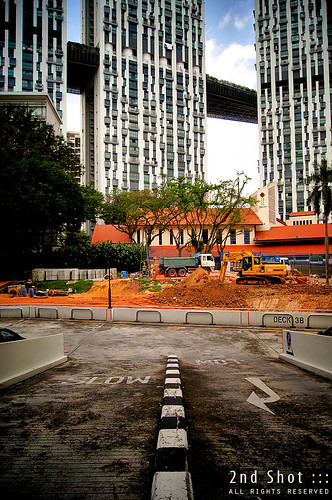
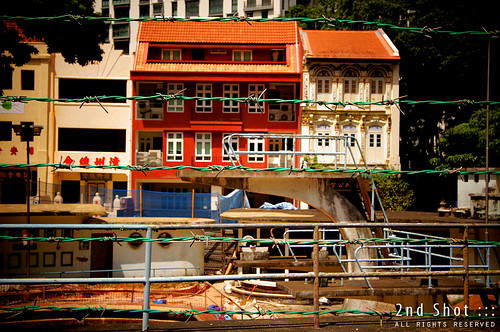
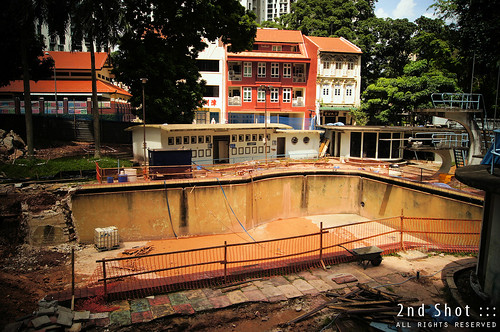
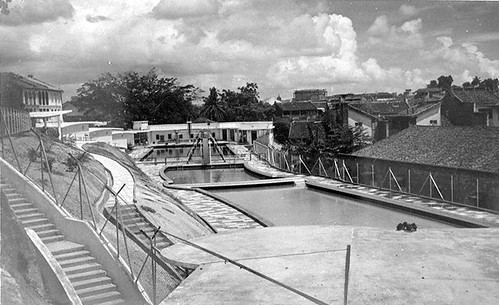
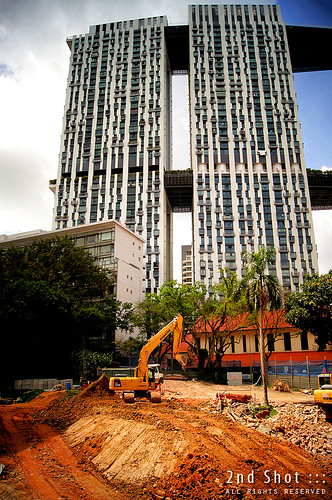
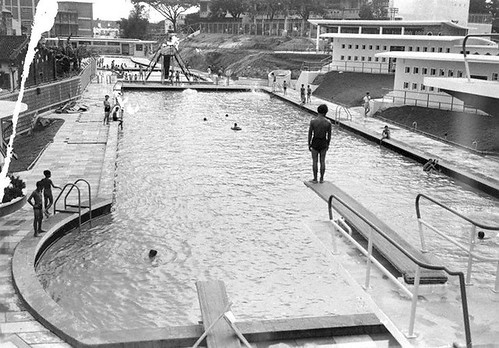











11 comments:
what do you mean with "is this a sign of thing to come?"
I feel sad that the former Yan Kit swimming pool was demolished. I thot it could be revived since there's an increase of population there with the Pinancle@Duxton. My brother and I swam there during our primary school days. Another icon or landmark has disappeared.
Haha, your use of perishing also sounds alarming.
I had the pleasure, while lost in the Tanjong Pagar area with my camera, to stumble across the Yan Kit Pool in all its livery a few years before its demolition. Its unique architecture and design harks back to a bygone era, an era which we have lost with the passing of this pool.
Honestly, I don't see how much land space can be salvaged from its demolition: The land lies in a peculiar wedged shaped plot of land barely enough to build anything. Perhaps more condominiums?
Toa payoh has a 4.5m diving pool too, with a 10m platform, though the SSC website lists only Queenstown as having a diving pool like you said. It's there but the general public is not allowed to use it. I frequently had my swimming lessons there in my pajamas :) almost 30 yrs ago.
Oh, so there are swimming complex like Toa Payoh with diving pool that is unlisted. Thanks Anon for the information!
An old swimming pool in the constituency helmed by the oldest MP being demolished is not a good sign. My use of perishing is indeed alarming!
I suspect the issue with Yan Kit is the maintenance and not the low human traffic as often claimed. The pool had history of faulty pipes and it is just not practical to maintain it.
Murugan ... thanks but no thanks if you are trying to spam.
i had my swimming lessons there in 1985 while as a sec 1 student at Gan Eng Seng School, nearby at the old Anson Road site. it was the first time i saw a diving platform and the deep pool!
I live in P@D. And some enthusiastic resident actually collected petition signatures (i cant remb the number but it was sizable) to retain the pool. Unfortunately it fell on deaf ears.
The pool had some underlying structural issues so would be expensive to maintain it.
Because P@D not EC, so residents would be clamoring for extra facilities. :P
Post a Comment